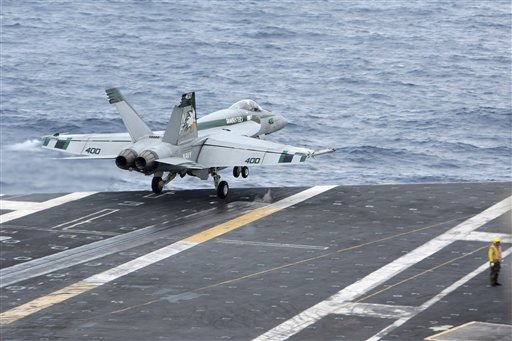By CHRIS BRUMMITT
Associated Press
ON BOARD THE USS GEORGE WASHINGTON
A U.S. aircraft carrier group cruised through the disputed South China Sea on Saturday in a show of American power in waters that are fast becoming a focal point of Washington’s strategic rivalry with Beijing.
Vietnamese security and government officials were flown onto the nuclear-powered USS George Washington ship, underlining the burgeoning military relationship between the former enemies. A small number of journalists were also invited to witness the display of maritime might in the oil-rich waters, which are home to islands disputed between China and the other smaller Asian nations facing the sea.
The visit will likely reassure Vietnam and the Philippines of American support but could annoy China, whose growing economic and naval strength is leading to a greater assertiveness in pressing its claims there. The United States is building closer economic and military alliances with Vietnam and other nations in the region as part of a “pivot” away from the Middle East to Asia, a shift in large part meant to counter rising Chinese influence.
The Vietnamese officials took photos of F-18 fighter jets taking off and landing on the ship’s 1,000-foot- (305-meter-) long flight deck, met the captain and toured the hulking ship, which has more than 5,000 sailors on board.
The mission came a day after Beijing staged military exercises near islands in the nearby East China Sea it disputes with U.S ally Japan. Those tensions have flared in recent days.
China claims nearly all of the South China Sea, where the U.S. says it has a national interest in ensuring freedom of navigation in an area crossed by vital shipping lanes. Vietnam, the Philippines and several other Asian nations also claim parts of the sea. The disputes attracted little international interest until the late 1990s, when surveys indicated possible large oil reserves. American rivalry with China has given the disputes an extra dimension in recent years.
The U.S. Navy regularly patrols the Asia-Pacific region, conducting joint exercises with its allies and training in the strategic region. The trip by the George Washington off the coast of Vietnam is its third in as many years. A second aircraft carrier, the USS John C. Stennis, has also conducting operations in the western Pacific region recently, according to the U.S. Pacific Fleet.
Capt. Gregory Fenton said the mission was aimed in part at improving relations with Vietnam and ensuring the U.S. had free passage in the South China Sea.
China’s military buildup, including the launch of its own carrier last year and rapid development of ballistic missiles and cyber warfare capabilities, could potentially crimp the U.S. forces’ freedom to operate in the waters. The United States doesn’t publicly take sides in the territorial disputes among China and its neighbors.
Although claimant countries have pledged to settle the territorial rifts peacefully, the disputes have erupted in violence in the past, including in 1988 when China and Vietnam clashed in the Spratly Islands in a confrontation that killed 64 Vietnamese soldiers. Many fear the disputes could become Asia’s next flash point for armed conflict.
Vietnam is pleased to accept help from its one-time foe America as a hedge against its giant neighbor China, with which it also tries to maintain good relations.
Still, the Hanoi government reacted angrily to recent moves by Beijing to establish a garrison on one of the Paracel islands, which Vietnam claims. The United States also criticized the move by Beijing, earning it a rebuke from the government there.
While most analysts believe military confrontation in the waters is highly unlikely anytime soon, they say tensions are likely to increase as China continues pressing its claims and building its navy.

COMMENTS
Please let us know if you're having issues with commenting.